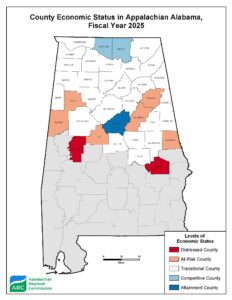No At-Risk Counties in TARCOG Region

Big news for DeKalb and Limestone counties as their economic statuses in the Appalachian Regional Commission (ARC) has improved for the upcoming year making the areas eligible for different types of funding opportunities.
TARCOG’s Director of Economic Planning and Development Lee Terry said the biggest takeaways from the recently announced status changes is that DeKalb moved from At-Risk to Transitional and Limestone moved from Transitional to Competitive for FY2025.
“With the current rankings, the only state with more transitional counties than Alabama in the ARC is Pennsylvania,” Lee said. “And Alabama and Georgia are the only two states in the ARC that has counties in the attainment category.
ARC computes new county economic levels each fiscal year based on the most current data available at the beginning of the calendar year of computation. This is good news for the TARCOG Region as the areas economy continues to thrive, Lee said.
“While we acknowledge the positive growth, we continue to have 18 areas that we will continue to focus on with our member governments.,” he added.
Below are the FY2025 designations for each county in the TARCOG region.
- DeKalb County has been designated as a transitional county in fiscal year 2025. The maximum ARC share for projects funded in this county is 50 percent. This county has seven distressed areas in fiscal year 2025.
- Limestone County is designated as a competitive county in fiscal year 2025. The maximum ARC share for projects funded in this county is 30 percent. This county has no distressed areas in fiscal year 2025.
- Jackson County is designated as a transitional county in fiscal year 2025. The maximum ARC share for projects funded in this county is 50 percent. This county has seven distressed areas in fiscal year 2025
- Madison County is designated as a competitive county in fiscal year 2025. The maximum ARC share for projects funded in this county is 30 percent. This county has no distressed areas in fiscal year 2025.
- Marshall County is designated as a transitional county in fiscal year 2025. The maximum ARC share for projects funded in this county is 50 percent. This county has four distressed areas in fiscal year 2025.

Since 2007, ARC has used an index-based county economic classification system to identify and monitor the economic status of Appalachian counties. The system involves the creation of a national index of county economic status through a comparison between national averages and that of each county’s averages for three economic indicators:
- Three-year average unemployment rate
- Per capita market income
- Poverty rate
The resulting values are summed and averaged to create a composite index value for each county. Each county in the nation is then ranked, based on its composite index value, with higher values indicating higher levels of distress. Each Appalachian county is classified into one of five economic status designations, based on its position in the national ranking.
- Distressed counties are the most economically depressed counties. They rank in the worst 10 percent of the nation’s counties.
- At-Risk counties are those at risk of becoming economically distressed. They rank between the worst 10 percent and 25 percent of the nation’s counties.
- Transitional counties are those transitioning between strong and weak economies. They make up the largest economic status designation. Transitional counties rank between the worst 25 percent and the best 25 percent of the nation’s counties.
- Competitive counties are those that are able to compete in the national economy but are not in the highest 10 percent of the nation’s counties. Counties ranking between the best 10 percent and 25 percent of the nation’s counties are classified competitive.
- Attainment counties are the economically strongest counties. Counties ranking in the best 10 percent of the nation’s counties are classified attainment.